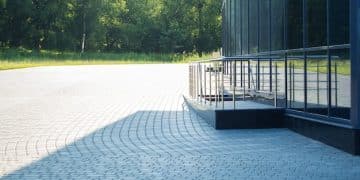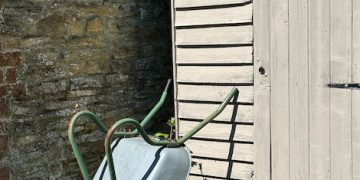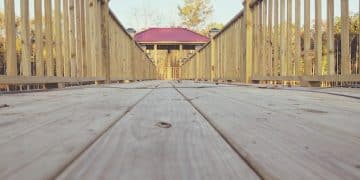Painting Your Home’s Exterior: A Step-by-Step Guide

Anúncios
Painting your home’s exterior involves careful preparation, priming, painting, and finishing touches for a long-lasting, aesthetically pleasing result, increasing kerb appeal and protecting your home from weather damage.
Ready to tackle a fresh coat of paint for your home’s facade? Painting your home’s exterior: A step-by-step guide for a lasting finish not only enhances its curb appeal but also protects it from the elements.
Anúncios
Why Painting Your Home’s Exterior Matters
Painting your home’s exterior is more than just an aesthetic upgrade; it’s a crucial maintenance task. A fresh coat of paint can significantly impact your property’s value and overall protection.
Let’s delve into the key reasons why you should consider this project.
Anúncios
Enhancing Curb Appeal
A well-maintained exterior speaks volumes. It creates a positive first impression, making your home more attractive to potential buyers or simply providing personal satisfaction.
Choosing the right colour and ensuring a flawless finish can dramatically enhance the overall look.
Protecting Against the Elements
Paint acts as a barrier against rain, wind, sun, and even pests. It prevents moisture from seeping into your home’s structure, which can lead to costly repairs.
Quality exterior paint is designed to withstand harsh weather conditions, extending the lifespan of your siding and trim.
- Increased Property Value: A fresh, clean exterior can increase your property’s market value.
- Prevention of Damage: Paint protects against water damage, mould, and insect infestations.
- Energy Efficiency: Certain paints can reflect sunlight, reducing cooling costs in summer.
In conclusion, painting your home’s exterior is a worthwhile investment that safeguards your property and enhances its visual appeal.
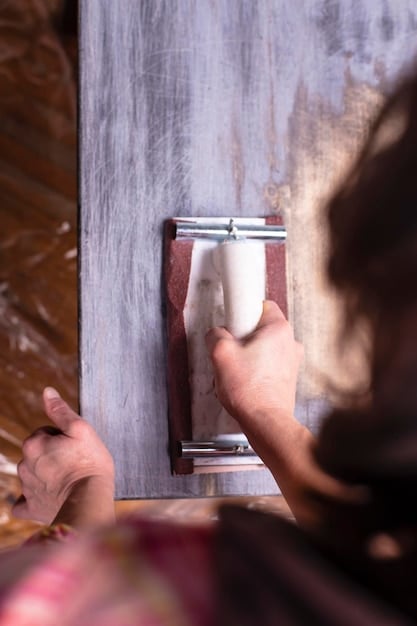
Essential Tools and Materials
To ensure a successful and lasting paint job, gathering the right tools and materials is crucial. This preparation phase can save time and prevent frustration later on.
Here’s a breakdown of what you’ll need.
Cleaning Supplies
Before you even think about painting, the exterior needs a thorough cleaning. This removes dirt, mildew, and loose paint that can compromise the new coat.
A pressure washer, scrub brushes, and a suitable cleaning solution are essential.
Painting Tools
Choosing the right brushes, rollers, and sprayers can significantly affect the finish quality and efficiency.
Different sizes and types are suitable for various surfaces and application techniques.
- Pressure Washer: For efficient cleaning of large surfaces.
- Scrub Brushes: For detailed cleaning and removing stubborn dirt.
- Paint Brushes: High-quality brushes for trim and detail work.
Selecting the correct tools and materials is the foundation for a professional-looking and durable paint job. Proper cleaning, the right applicators, and quality paint are essential for a successful outcome.
Step-by-Step Preparation Process
Proper preparation is key to achieving a flawless and long-lasting exterior paint job. Neglecting this crucial step can lead to peeling, bubbling, and other issues.
Follow these essential preparation steps to ensure a smooth and durable finish.
Cleaning the Exterior
Start by thoroughly cleaning your home’s exterior. Use a pressure washer or a scrub brush with a mild detergent solution to remove dirt, mildew, and loose paint.
Pay attention to corners, crevices, and areas prone to mould growth.
Repairing Damaged Areas
Inspect the exterior for any damage, such as cracks, holes, or rotten wood. Repair these areas before painting to prevent further deterioration.
Use appropriate fillers, sealants, and wood replacements to restore the surfaces.
Scraping and Sanding
Remove any loose or peeling paint by scraping it with a paint scraper. Then, sand the surface to create a smooth, even texture.
This ensures that the new paint adheres properly and provides a professional finish.
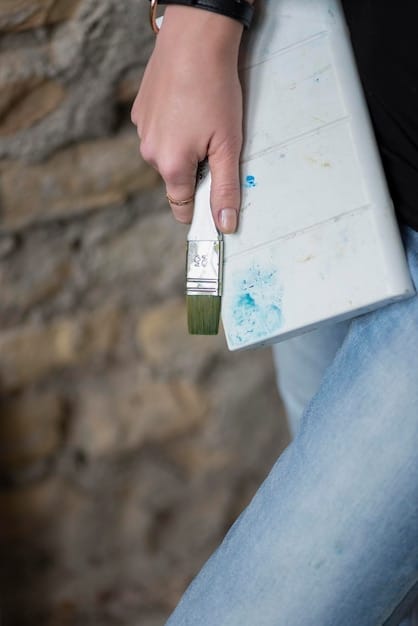
Priming for Success
Priming is an often overlooked but essential step in painting your home’s exterior. It creates a uniform surface, improves paint adhesion, and enhances the overall durability of the finish.
Let’s explore why priming is so important.
Why Priming Matters
Primer acts as a bonding agent between the surface and the paint. It seals porous materials, blocks stains, and provides a smooth base for even colour application.
Skipping this step can lead to uneven coverage, peeling, and premature paint failure.
Choosing the Right Primer
Selecting the appropriate primer depends on the surface you’re painting and the type of paint you’ll be using. Consider factors like moisture resistance, stain blocking, and adhesion properties.
Consult with a paint professional to determine the best primer for your specific needs.
Application Techniques
Apply the primer evenly, using brushes, rollers, or sprayers, depending on the surface area and texture. Allow the primer to dry completely before applying the first coat of paint.
Follow the manufacturer’s instructions for optimal results.
- Improved Adhesion: Primer ensures that the paint adheres properly to the surface.
- Uniform Surface: It creates a smooth, even base for consistent colour application.
- Enhanced Durability: Primer protects against moisture and other environmental factors.
In conclusion, priming is a crucial step that should not be skipped. It enhances adhesion, creates a uniform surface, and improves the overall durability of your exterior paint job, ensuring a lasting and professional-looking finish.
Painting Techniques for a Flawless Finish
Achieving a flawless finish when painting your home’s exterior requires more than just applying paint. Mastering various techniques can significantly improve the outcome.
Here’s a guide to help you achieve professional results.
Brush Techniques
Using a brush effectively involves proper loading, consistent strokes, and attention to detail. Hold the brush at a comfortable angle and apply even pressure.
For trim and edges, use a smaller brush and take your time to ensure clean lines.
Roller Techniques
Rollers are great for covering large surfaces quickly. Load the roller evenly with paint and use a ‘W’ pattern to distribute the paint uniformly.
Overlap each stroke slightly to avoid streaks and ensure consistent coverage.
Spraying Techniques
Spraying can provide a smooth, even finish on textured surfaces. Maintain a consistent distance from the surface and use overlapping strokes.
Practice on a test area to get the hang of the technique before painting the entire exterior.
- Even Coats: Apply thin, even coats to prevent drips and runs.
- Proper Overlap: Overlap each stroke to ensure consistent coverage.
- Clean Equipment: Keep your brushes, rollers, and sprayers clean for optimal performance.
Mastering these techniques, combined with careful preparation and quality materials, will help you achieve a flawless and durable exterior paint job.
Final Touches and Maintenance
Once the painting is complete, the final touches and ongoing maintenance are crucial for preserving the beauty and longevity of your work. These steps ensure that your hard work pays off in the long run.
Let’s explore the essential final touches and maintenance tips.
Clean-Up
Proper clean-up is vital for maintaining your tools and ensuring future projects go smoothly. Clean brushes, rollers, and sprayers immediately after use.
Dispose of paint cans and other materials responsibly, following local regulations.
Inspection and Touch-Ups
Inspect the painted surface for any imperfections, such as drips, runs, or missed spots. Touch up these areas carefully to achieve a flawless finish.
Allow the paint to fully cure before making any significant corrections.
Regular Maintenance
To keep your home’s exterior looking its best, perform regular maintenance. This includes washing the surface to remove dirt and grime, and addressing any signs of wear or damage promptly.
Periodic inspections can help identify potential issues before they become major problems.
| Key Point | Brief Description |
|---|---|
| ✨ Preparation | Clean, repair, and sand the exterior surface thoroughly before painting. |
| 🛡️ Priming | Apply a suitable primer to improve paint adhesion and ensure a uniform finish. |
| 🎨 Painting | Use proper techniques for brushing, rolling, or spraying to achieve even coverage. |
| 🧹 Maintenance | Clean regularly and touch up any imperfections to prolong the life of the paint. |
Frequently Asked Questions
▼
The frequency depends on factors like climate, paint quality, and siding material. Generally, repainting every 5-10 years is recommended to maintain protection and appearance.
▼
The ideal time is during mild, dry weather. Avoid painting in extreme heat, cold, or when rain is expected, as these conditions can affect paint adhesion and drying time.
▼
Yes, but only if the old paint is in good condition. Remove any loose or peeling paint, and lightly sand the surface before applying a primer and fresh coat of paint.
▼
Consider your home’s architectural style, surrounding landscape, and personal preferences. Test paint samples in different lighting conditions to see how the colours appear throughout the day.
▼
Hiring a professional ensures a high-quality, long-lasting finish, as they have the expertise and equipment. DIY can save money but requires time, effort, and attention to detail for good results.
Conclusion
By following this step-by-step guide, you can confidently tackle your home’s exterior painting project, achieving a beautiful and durable finish that enhances its curb appeal and protects it from the elements. Remember, preparation, quality materials, and attention to detail are key to a lasting and successful outcome.
